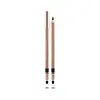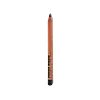What's inside
What's inside
 Key Ingredients
Key Ingredients

 Benefits
Benefits

 Concerns
Concerns

 Ingredients Side-by-side
Ingredients Side-by-side

Hydrogenated Jojoba Oil
AbrasiveCaprylic/Capric Triglyceride
MaskingLimnanthes Alba Seed Oil
Skin ConditioningHydrogenated Cottonseed Oil
EmollientMangifera Indica Seed Oil
EmollientEuphorbia Cerifera Wax
Glyceryl Caprylate
EmollientMacadamia Integrifolia Seed Oil
Skin ConditioningCopernicia Cerifera Wax
Tocopherol
AntioxidantChamomilla Recutita Flower Extract
MaskingAscorbyl Palmitate
AntioxidantMica
Cosmetic ColorantCI 77891
Cosmetic ColorantCI 77491
Cosmetic ColorantCI 77492
Cosmetic ColorantCI 77499
Cosmetic ColorantCI 77007
Cosmetic ColorantHydrogenated Jojoba Oil, Caprylic/Capric Triglyceride, Limnanthes Alba Seed Oil, Hydrogenated Cottonseed Oil, Mangifera Indica Seed Oil, Euphorbia Cerifera Wax, Glyceryl Caprylate, Macadamia Integrifolia Seed Oil, Copernicia Cerifera Wax, Tocopherol, Chamomilla Recutita Flower Extract, Ascorbyl Palmitate, Mica, CI 77891, CI 77491, CI 77492, CI 77499, CI 77007
Caprylic/Capric Triglyceride
MaskingButyl Stearate
EmollientC30-45 Alkyl Methicone
EmollientC30-45 Olefin
Skin ConditioningHydroxystearic Acid
CleansingHydrogenated Cottonseed Oil
EmollientStearic Acid
CleansingPalmitic Acid
EmollientTocopherol
AntioxidantAscorbyl Palmitate
AntioxidantCI 77491
Cosmetic ColorantCI 77007
Cosmetic ColorantMica
Cosmetic ColorantCI 77742
Cosmetic ColorantCI 77891
Cosmetic ColorantCI 77510
Cosmetic ColorantCI 75470
Cosmetic ColorantIngredients Explained
These ingredients are found in both products.
Ingredients higher up in an ingredient list are typically present in a larger amount.
Ascorbyl Palmitate is created by combining pure Vitamin C and palmitic acid. It is an antioxidant and helps reduce hyperpigmentation.
This ingredient is a more stable version of Vitamin C, meaning it does not disintegrate as quickly when exposed to sunlight. However, studies show it does not penetrate skin as well as pure Vitamin C.
Ascorbyl Palmitate is oil soluble.
Read more about other types of Vitamin C:
Learn more about Ascorbyl PalmitateThis ingredient is an emollient, solvent, and texture enhancer. It is considered a skin-softener by helping the skin prevent moisture loss.
It helps thicken a product's formula and makes it easier to spread by dissolving clumping compounds.
Caprylic Triglyceride is made by combining glycerin with coconut oil, forming a clear liquid.
While there is an assumption Caprylic Triglyceride can clog pores due to it being derived from coconut oil, there is no research supporting this.
Learn more about Caprylic/Capric TriglycerideThis pigment is called Ultramarine blue lazurite. It gives a saturated blue color, but can be used to create other colors as well.
According to the manufacturer, it is usually made from kaolin, sodium sulfate, sodium carbonate, sulfur, and charcoal.
Ci 77491 is also hydrated iron III oxide. It's sole purpose is to give a red/pink hue to products.
Iron III oxides are classified as inorganic chemicals for coloring.
Synthetically created Ci 77491 is considered safer than those naturally found. This is because the synthetically created version may contain less impurities. Iron oxides are generally non-toxic and non-allergenic.
Learn more about CI 77491Ci 77891 is a white pigment from Titanium dioxide. It is naturally found in minerals such as rutile and ilmenite.
It's main function is to add a white color to cosmetics. It can also be mixed with other colors to create different shades.
Ci 77891 is commonly found in sunscreens due to its ability to block UV rays.
Learn more about CI 77891Hydrogenated Cottonseed Oil is an oil. It can be bad for acne prone skin.
Mica is a naturally occurring mineral used to add shimmer and color in cosmetics. It can also help improve the texture of a product or give it an opaque, white/silver color.
Serecite is the name for very fine but ragged grains of mica.
This ingredient is often coated with metal oxides like titanium dioxide. Trace amounts of heavy metals may be found in mica, but these metals are not harmful in our personal products.
Mica has been used since prehistoric times throughout the world. Ancient Egyptian, Indian, Greek, Roman, Aztec, and Chinese civilizations have used mica.
Learn more about MicaTocopherol (also known as Vitamin E) is a common antioxidant used to help protect the skin from free-radicals and strengthen the skin barrier. It's also fat soluble - this means our skin is great at absorbing it.
Vitamin E also helps keep your natural skin lipids healthy. Your lipid skin barrier naturally consists of lipids, ceramides, and fatty acids. Vitamin E offers extra protection for your skin’s lipid barrier, keeping your skin healthy and nourished.
Another benefit is a bit of UV protection. Vitamin E helps reduce the damage caused by UVB rays. (It should not replace your sunscreen). Combining it with Vitamin C can decrease sunburned cells and hyperpigmentation after UV exposure.
You might have noticed Vitamin E + C often paired together. This is because it is great at stabilizing Vitamin C. Using the two together helps increase the effectiveness of both ingredients.
There are often claims that Vitamin E can reduce/prevent scarring, but these claims haven't been confirmed by scientific research.
Learn more about Tocopherol